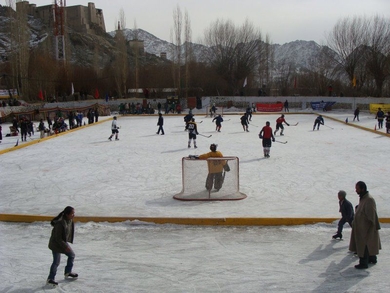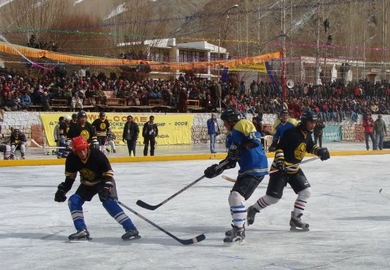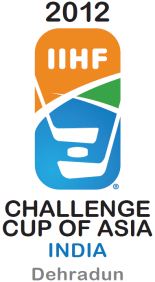LEH, India – In the northern Indian province of Ladakh, ice hockey is one of the most popular sports. Here, Muslim and Buddhist girls chase the puck at an altitude of 4,000 metres.
German travel writer Oliver Schulz of the weekly
Die Zeit travelled to the area and reports from India prior to the
2012 IIHF Challenge Cup of Asia in the country.
The afternoon sun is going down behind the snow-capped mountains in Pargive, west of the Himalayas. Saida Hadi and her friend Zahara float over the ice of river Chiktan on their blades and battle for a piece of root wood that serves as a puck.
Smiling and gasping, the girls chase each other around thick poplar trees that loom over the frozen stream.
A group of boys has come together on a simple stand made of concrete slabs. They’re busy handling their mobile phones; sometimes one of them looks over to the girls.
Nearby, a couple of kids with self-made sledges formed of petrol cans cheeringly slide down a frozen tributary.
Others are practising shots with self-carved sticks made of branches on a goal marked by lumps of rocks, while two yaks look for dry grass in the riverbed.
It’s typical scenery for Ladakh. Ice hockey has a long tradition in this remote high-mountain region in the north of India.
However, this tradition had been dominated exclusively by men for decades.
The first public ice hockey games in the area were staged by the Ladakh Scouts, a battalion of the Indian army, in the ‘70s on a frozen reservoir in Leh, the district’s capital.
The local population got excited for the sport, was seeing it as a solution for lack of variety in leisure activities in the area, especially during the tough winters.
Soon after, Ladakhers in the north Indian city of Shimla flew in blades. Two Chinese craftsmen specialised in producing them, and locals screwed them under their winter boots.
With basic hockey sticks and pucks that were cut from army boot heels, they soon started to have civil hockey competitions on the reservoir in downtown Leh.
Nowadays, Ladakh is India’s ice hockey hotbed. There are almost 20 clubs from the Muslim west up to the highlands settled by Tibetan nomads in the east. Sometimes even tourists travel to Ladakh to play hockey.
The team of the Canadian High Commission in Delhi plays against a local selection at the ice stadium of Leh every year. Volunteer coaches from Canada and the U.S. spend the winter in the region to coach juniors.
 An ice hockey game at the foot of the Himalayas. Photo: IHAI
An ice hockey game at the foot of the Himalayas. Photo: IHAIWhen some years ago more and more girls started to take their brothers’ sticks and step onto the ice, local clubs were appalled at first. That’s just not done, according to the patriarchal argument.
But the Ice Hockey Association of India based in New Delhi is fully behind the girls, providing equipment and coaches in hopes of forming a women’s team for international tournaments.
Up to now the IHAI’s ambitious goal hasn’t been achieved, but the chances grow each winter. Meanwhile, there are currently five female amateur teams playing in Ladakh.
The next morning hockey player Saida says goodbye to her parents in the village of Pargive in western Ladakh and hits the 180-kilometre long road to Phey, close to the district’s capital of Leh, in a shared taxi. There she’s visiting a school and playing hockey on the team of the Students’ Educational and Cultural Movement of Ladakh (Secmol), a non-governmental organisation.
The 19-year-old appears to be relieved. “There’s more going on in Phey than in my village. We always have electricity, even in the nights,” she says. “And we meet people from the whole country, sometimes even tourists.”
Saida is Muslim. She wears a traditional, knee-long woollen shawl and turquoise pants. Her fingernails are coloured orange. She says she wants to become a teacher one day so she can teach reading and writing to the poor in her village. Or become a travel guide.
But under no circumstances does Saida want to become a housewife like her mother.
Her mother doesn’t have anything against letting Saida search her own way. Even at her daughter’s sporting hobby the mother looks at with goodwill.
When she was seven years old, Saida stood on skates for the first time. When she was nine, she was already playing hockey at temperatures below freezing point on the river that divides her village.
“I love to battle,” Saida says with a broad smile, “to play tough, to use my body.”
Then she’s quoting her mother: “Your brothers have played in the army. Now you play at school. That’s how it is. Times are changing.”
After a half-hour ride the shared taxi has reached the first Buddhist village. On the main road prayer flags are waving between power poles. Some snow must have fallen in the night, but now the morning sun is rising quickly into the deep blue sky.
The shadowy flank of the Himalayas is snow-covered until the large valley. The flatter Karakorum hills in the north are almost barren. The taxi drives across entirely frozen rivers and creeks, even whole waterfalls have become solidified.
During a break Saida phones with her mother, who wants to give her some instructions to take on the journey. The young lady chatters on her phone, laughs out loudly, the right hand leant on her hip. She appears strong, almost insubordinate between the old gentlemen who promenade through the street in red or brown robes.
The sport gives the girls the self-confidence that frightens many Ladakhers with their traditional role perception. Especially here on the countryside, and with the older generations.
After two more hours on the road, the river Zanskar breaks out of a Himalaya canyon, pale blue between the brown foot of the mountains and mostly capped with a layer of ice.
In January and February, locals use the frozen river as a shortcut to the valley of the same name that’s cut off for months.
Among venturous western trekkers, the one-week long path has become popular as a spectacular winter tour.
Only few hours remain to rest after the bus has reached Leh in the evening. An ice hockey tournament is waiting in a town close to the border with China.
While drinking Tibetan butter tea in the common kitchen of her accommodation, Saida’s teammate Padma explains why the future of ice hockey in Ladakh belongs to the women: “Because we have more tactfulness than the boys. We’ve got the technical skills better than them.”
The other girls smile, agreeing with her. India’s female hockey players won’t fail on lack of self-confidence, that’s for sure.
The morning after, Saida and the Secmol Girls drive towards the Karakorum range from the large Indus valley up to a narrow, snowy canyon.
The sense of excitement about the trip is almost dissembled among the girls, but maybe that’s just due to the wee hours of the morning. Many of them have fallen asleep on the shoulders of their neighbours; only few chat with each other.
During a break at the Chang pass summit Saida has herself photographed with a yellow boundary stone by a teammate. “5,300 metres,” it reads in English. “The highest drivable pass in the world.”
Beyond the mountain ridge comes the Lalok region with its capital Tangtse, roughly 4,000 metres high. A valley almost without vegetation, with significantly less snow.
Tangtse marks the western edge of Changthang, a high plateau that ranges until Tibet. The region is settled almost exclusively by nomads who drive their yak and sheep herds through the plateau desert.
 Thousands of fans watch a game of the national championship at the ice stadium in Leh. Photo: IHAI
Thousands of fans watch a game of the national championship at the ice stadium in Leh. Photo: IHAIThe preparations for the tournament have been going on since the morning. Unevenness is being scratched from the ice with a sheet of corrugated iron.
A man is mixing paint in sliced milk cartons and brushes the lines onto the ice. Loudspeakers are being tested while a flock of cackling bar-headed geese waddle around the playing field. A red carpet is being rolled out from the VIP stand.
In fact the competition should have started at 9am, but the men’s teams arrive one hour later.
“The boys in Ladakh are sometimes a bit sluggish,” moans Padma. “Let’s hope the ice won’t have melted under the sun until it’ll be our turn in the afternoon.”
Sports-mad soldiers in civil outfits, teenagers and old mothers from the surrounding villages cavort on the stands.
Reaching the afternoon, a big puddle has been formed indeed under the glittering sun on centre ice. The girls have to play under clearly more difficult conditions than the boys.
Saida plays on the right wing. She’s moving strongly, almost masculine. She’s one of the tallest girls on the ice.
Ten minutes into the game the score is 2-0 for the Secmol Girls. And it’s Saida, who nets the last goal right before the final whistle with a shot from distance, with full force, that goes past the right shoulder of the opponent’s goalkeeper.
Proud about their victory, the girls leave the ice. While the girls embrace each other with smiles on their faces, the boys from Leh are celebrating the girls’ win by “Secmol!” cheers.
When Saida takes off her helmet, it seems that tension is also released from her.
“If we had lost, I would have cried,” she says.
OLIVER SCHULZ (Die Zeit, original version)
MARTIN MERK (IIHF, English translation)
Note: The
2012 IIHF Challenge Cup of Asia in Dehradun will be the first-ever IIHF tournament played in India. The event starts on Saturday.
This translated story is published with the kind permission of German weekly Die Zeit. The original story in German was published in the 01/2012 edition and can be found here.







